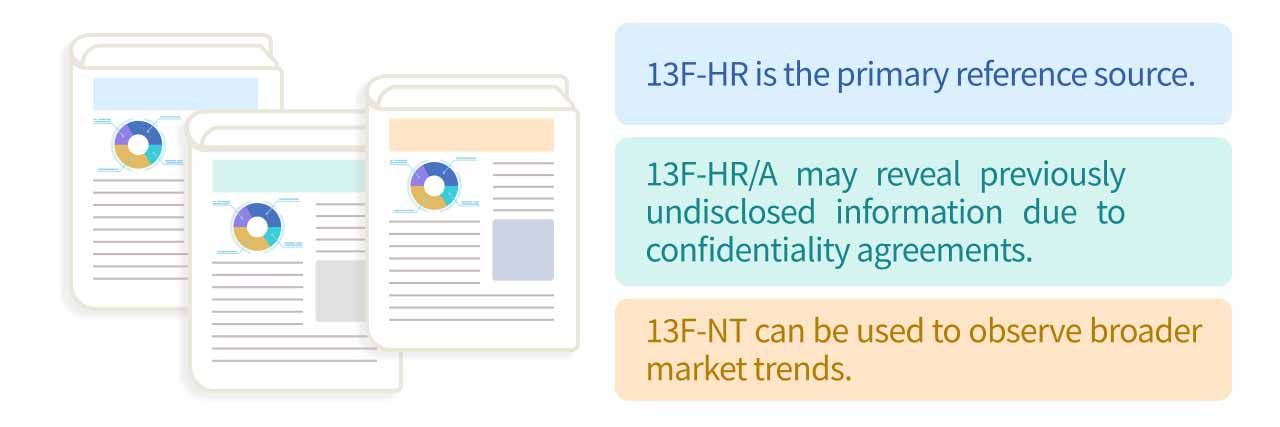Investors always hope to maximize their returns, yet it’s inevitable to worry about heading in the wrong direction on the investment path. Just as copying calligraphy is the best way to begin learning the art, mimicking the portfolio strategies of large institutions and seasoned fund managers can help retail investors avoid unnecessary detours.
The fastest way to understand the investment strategies of these major players is through the quarterly 13F reports submitted by institutions. This article introduces the purpose and analysis techniques of the 13F report, with examples for better understanding.
Introduction to the 13F Report
According to the U.S. Securities and Exchange Commission (SEC), investment institutions with assets under management (AUM) exceeding $100 million—including banks, hedge funds, and individuals or entities with investment discretion—are required to submit Form 13F regularly. These reports detail all long positions held by the institution, primarily disclosing equity holdings. Fund managers must file their reports within 45 days after the end of each quarter, and the reports are publicly available on the SEC’s website. To avoid revealing their investment strategies, most institutions submit their reports right at the deadline.
Differences Between 13F-HR, 13F-HR/A, and 13F-NT

| 13F-HR | 13F-HR/A | 13F-NT | |
|---|---|---|---|
| Purpose & Content | Standard quarterly holdings report listing all long positions including stocks, ETFs, bonds, etc. | Amendment or addition to a previously submitted quarterly report | Declares that the institution's holdings are already included in another institution’s report and does not require separate filing |
| Filing Deadline | Within 45 days after the end of each quarter | Can be submitted anytime | Submitted along with the merged institution's 13F-HR report |
| Holdings Disclosure | ✔︎ Full holdings disclosure | ✔︎ Amendments show updated or added holdings (should be compared to the original) | ✘ Holdings are included in another institution’s report |
For investors, the 13F-HR remains the most valuable reference, as it reveals the latest portfolio positions of institutional investors. While 13F-HR/A typically reflects minor amendments, it can still offer insights, especially if prior omissions were due to confidentiality. Such updates may uncover new opportunities.
In addition, large investment institutions often manage multiple subsidiaries and may consolidate filings based on operational structure. If a company’s holdings are included in another institution's 13F-HR, the 13F-NT will indicate the consolidated entity. Although it’s difficult to separate each entity’s holdings in a merged report, the overall trend remains a crucial reference for investors.
Key Insights from 13F Reports: How to Read the Market
Identify Sector Trends and Popular Stocks
Investors can use the 13F report to track the largest increases or decreases in holdings by institutions or fund managers, thus revealing current asset or industry preferences among major players. A significant increase may indicate strong confidence in a stock’s potential, while a sharp reduction suggests the opposite. If a position is added or reduced for two consecutive quarters, it’s commonly seen as a bullish or bearish signal. From a macro perspective, watching broader trends across multiple institutions provides a forward-looking view of market sentiment.
AUM Trends Over Time
Changes in AUM effectively reflect an institution’s operational performance and ability to adapt to market conditions. In times of market turbulence, large fund managers with stable or growing AUM often demonstrate sound risk control and asset allocation, making them more attractive for long-term investors.
Differences in Investment Styles
Investors can choose which type of institution to follow based on their own investment preferences. For example, Warren Buffett, the hallmark of value investing, favors companies with strong fundamentals and steady cash flows. Value-oriented investors can look to his portfolio for inspiration. On the other hand, Cathie Wood, a leading growth investor, focuses on disruptive and high-growth industries. Those pursuing growth might follow her strategy to tap into emerging sectors early for substantial gains.
Interpreting Market Positioning
Since institutions required to file 13F manage significant assets, their buying and selling activities can have a major impact on market movements. When these entities collectively buy or sell a stock in large volumes, it often causes noticeable price swings. By analyzing shifts in institutional holdings and capital flows, retail investors can better gauge demand trends and identify optimal entry or exit points.
Caution: Potential Data Incompleteness Holdings data often reveal managerial strategies, and to avoid detection by competitors, institutions tend to file at the last moment. By the time retail investors see the report, it’s typically already six weeks old—reducing its actionable value. Moreover, 13F reports do not show short positions, meaning retail investors can't see which assets institutions are bearish on or detect any hedging strategies—missing key risk indicators.
Conclusion
In today's environment of asymmetric information, the 13F report has become an essential tool for retail investors. First, define your own investment goals and preferences, then follow institutions or investors you align with. Elevate your perspective by observing broader capital trends in the market. Only by effectively leveraging 13F insights can investors stay ahead and improve their chances of success.
